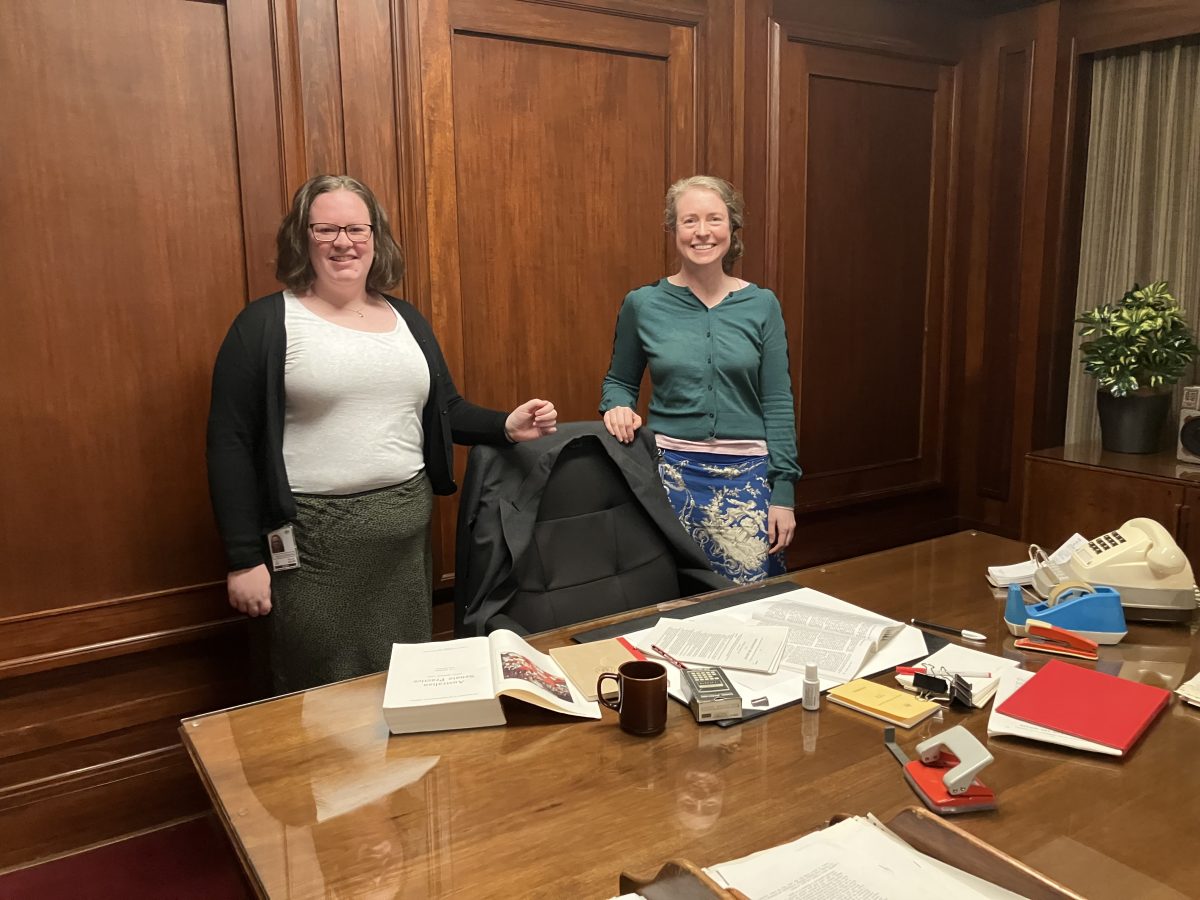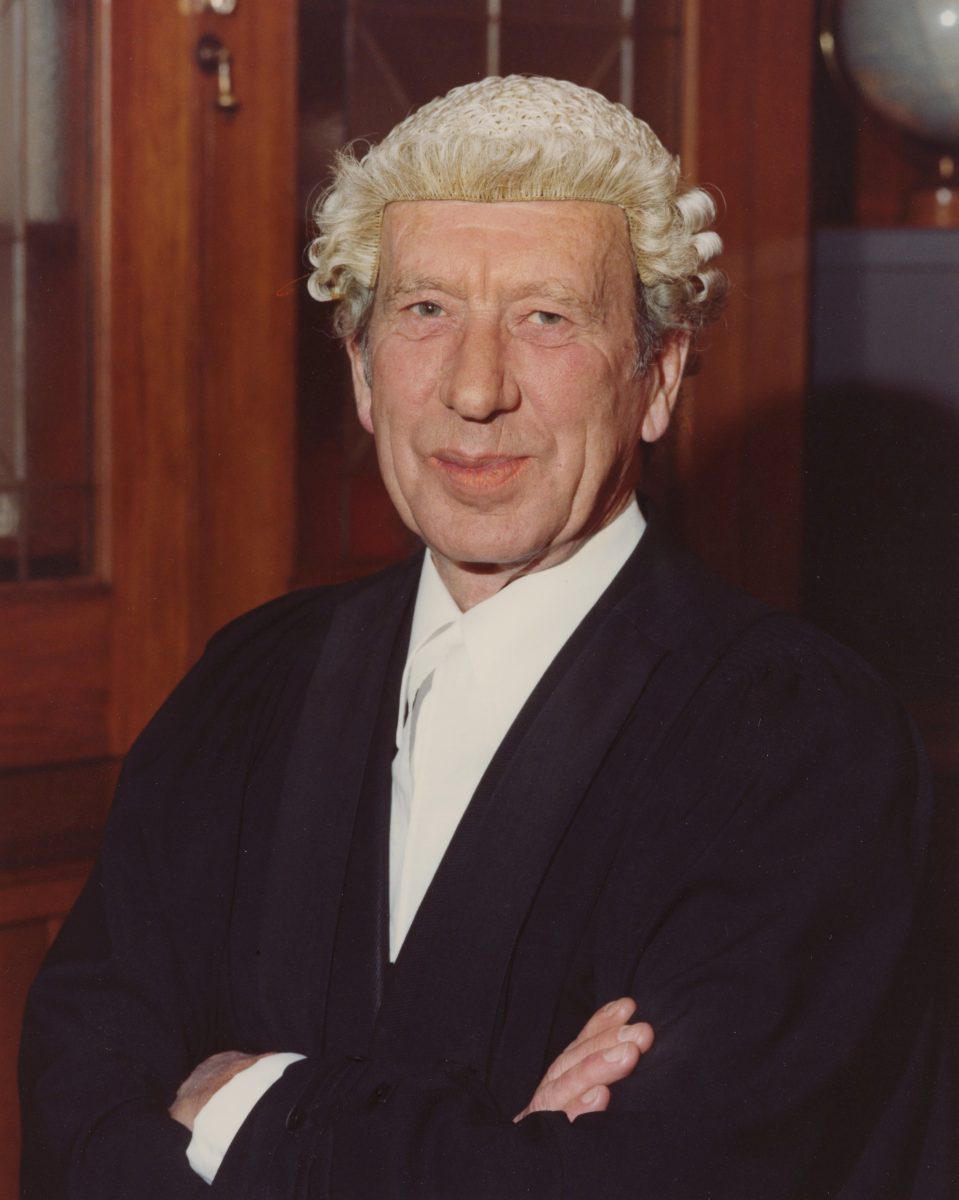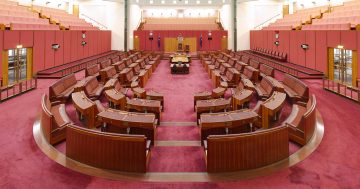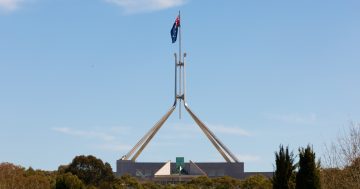
Alice McKenzie Ebbels and Dr Alex Wood in Old Parliament House’s clerk of the senate office as it currently looks. Photo: Region.
Etched in Australia’s collective psyche is the image from 11 November 1975 on the steps of what was then still the current Parliament House.
The late David Smith (later Sir David), who was at the time the official secretary to governor-general Sir John Kerr, is reading the proclamation to dissolve the Labor government of Gough Whitlam.
Over Smith’s right shoulder suddenly appeared a smirking Gough, observing the speech and waiting his turn to address the gathered throng.
Standing to the left of Smith was another important figure there in an impartial but official capacity to witness the events of what we have called since that infamous day the Dismissal.
His name was James Odgers. He was the clerk of the senate and was there on the steps of Parliament House dressed in a ceremonial cape and legal wig.
With the 50th anniversary of the Dismissal only 18 months away, the Museum of Australian Democracy at Old Parliament House is on a mission to recreate the clerk of the senate’s office in time for the anniversary year.
Alex Walton is MoAD’s interpretation and content development coordinator and, along with colleague Alice McKenzie Ebbels, has grand plans for the office.
“What we’re doing is reinterpreting the clerk of the senate office that’s on our main floor and currently open to visitors,” Dr Walton said.
“The current interpretation in that space is based on the 1980s period and was done a while ago, so it is more of a loose time period interpretation.
“What we tend to do with our recreated spaces these days is home on a particular date, and what we’re looking forward to doing in the clerk of the senate office is recreating it to the date of the Dismissal of the Whitlam government.”
Interpretation is an interesting term, and the uniqueness of the task is not lost on the curator.
She knows she has a “good gig” and this particular assignment has the team fired up – and it is very much to do with Odgers.
“It’s doubly exciting because that is a very key date in the history of this building and the history of the Australian government, but also it happened to be in the time when a particularly interesting clerk of the senate occupied that office,” Dr Walton said.
“His name was James Odgers and he has a nickname – the Guardian of the Senate.
“He was a real driver of change in the Australian senate and the role it plays in our parliamentary system, and he was really devoted to the senate and the important role that it can play.
“Before he even became clerk of the senate, he took it upon himself to write a book on the procedure of the senate.”
That might ring a few bells for political watchers.
Odgers’ Australian Senate Practice, currently in its 14th edition, was first published in 1953 and was then simply called Australian Senate Practice.

James Odgers, Clerk of the Senate on the day of the Dismissal. Photo: MoAD.
James Rowland Odgers was then usher of the black rod and clerk of committees when his book was first published.
He served as clerk of the senate from 1965 to 1979 and worked on subsequent editions of the book until his death in 1985.
The last edition he worked on, the 6th, was published in 1991 and renamed in his honour as Odgers’ Australian Senate Practice.
Beyond his attention to his work, Odgers was also a fascinating character.
Largely self-educated, he left high school during the Depression era and later decided to go to night school for a bookkeeping and administration course.
One of his most outstanding features was that, by all accounts, he was an amazing snooker player.
“His son tells us that he actually hustled his way through night school by playing snooker,” Dr Walton says.
“We know he definitely played snooker when he was having some downtime occasionally here in Parliament House. Yes, there was a pool table here in the members’ dining room bar.”
Odgers also suffered from a bad back (from the snooker, maybe?), and so there wasn’t much by way of chairs in his office.
The light fittings were more chandelier-like than the 1980s fluoros that currently furnish the room.
Those details and much more will be recreated in the office Odgers occupied.
Research through old minutes, photographs and footage, and through interviewing relatives and former colleagues will help the curators present an accurate picture of the office on the day Gough was sacked.
“We have to gather as much information as we can about what the space looked like at the time,” Dr Walton said.
“And we have to do everything we can to bring the space back to that era, which is not always easy to do. There have been changes to this building over the years.”
But they’re up for the task.
Help the Museum of Australian Democracy at Old Parliament to recreate the clerk of the senate’s office by donating to their Annual Appeal.
Original Article published by Chris Johnson on Riotact.









